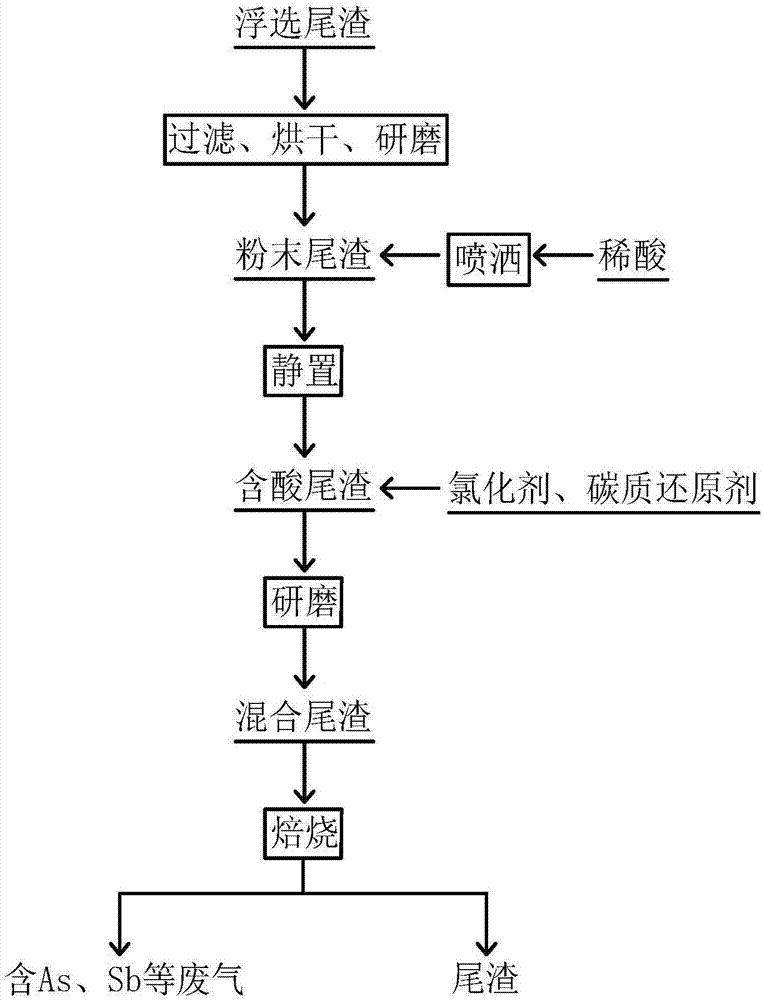Method for treating floatation tailings of waste magnesite-chrome refractory material
A technology for refractory materials and tailings, which is applied in the field of comprehensive recycling of refractory materials, can solve problems such as affecting the performance of refractory materials, affecting the production line, affecting the environment, etc., and achieves the effect of realizing reuse, preventing the impact of the environment, and a simple method.
- Summary
- Abstract
- Description
- Claims
- Application Information
AI Technical Summary
Problems solved by technology
Method used
Image
Examples
Embodiment 1
[0027] The raw material used is the discarded furnace lining of a silver smelting furnace in a lead smelter in Hunan - magnesia-chromium refractory bricks, and the flotation tailings after the main metals are recovered through the flotation process. The tailings contain 0.54% As and 3.13% Sb.
[0028] Take the flotation tailings, after being filtered by a vacuum filter, place them in an electric blast drying oven for drying at 80°C, and grind the obtained dry tailings in an agate grinder for 20 minutes to make them evenly dispersed and make them 85-90% of the particles are smaller than 0.074mm in size. The concentration is 5mol / L dilute hydrochloric acid, the tailings and dilute acid solution are mixed evenly according to the weight percentage of 20:1, and the standing time is 12h.
[0029] Grind the coarse reductant coke powder with a vibration mill for 0.5min to make the particle size less than 0.15mm. The acid-treated tailings, coke powder and magnesium chloride are mixed ...
Embodiment 2
[0032] The raw material used is the discarded furnace lining of a lead smelting furnace in a lead smelting plant in Hunan - magnesia-chromium refractory bricks, and the flotation tailings after the main metals are recovered through the flotation process. The tailings contain 0.95% As and 1.88% Sb.
[0033] Take the flotation tailings, after being suction filtered by a vacuum filter, place them in an electric blast drying oven for drying at 70°C, and grind the obtained dry tailings in an agate grinder for 40 minutes to make them evenly dispersed and make them 85-90% of the particles are smaller than 0.074mm in size. The concentration of the preparation is 6mol / L dilute hydrochloric acid, the tailings and the dilute acid solution are mixed evenly according to the weight percentage of 20:0.8, and the standing time is 11h.
[0034] Grind the coarse reductant carbon powder with a vibration mill for 0.8min to make the particle size less than 0.15mm. The acid treatment tailings, car...
Embodiment 3
[0037] The raw material used is the discarded furnace lining of a lead smelting furnace in a lead smelting plant in Hunan - magnesia-chromium refractory bricks, and the flotation tailings after the main metals are recovered through the flotation process. The tailings contain 0.75% As and 1.38% Sb.
[0038] Take the flotation tailings, after being suction filtered by a vacuum filter, place them in an electric blast drying oven for drying at 60°C, and grind the obtained dry tailings in an agate grinder for 40 minutes to make them evenly dispersed and make them 85-90% of the particles are smaller than 0.074mm in size. The configuration concentration is 4mol / L dilute sulfuric acid, the tailings and dilute acid solution are mixed evenly according to the weight percentage of 20:1.2, and the standing time is 10h.
[0039] Grind the coarse reducing agent graphite powder with a vibrating mill for 1 min to make the particle size smaller than 0.15 mm. Mix acid treatment tailings, graphite...
PUM
| Property | Measurement | Unit |
|---|---|---|
| particle diameter | aaaaa | aaaaa |
| boiling point | aaaaa | aaaaa |
| boiling point | aaaaa | aaaaa |
Abstract
Description
Claims
Application Information
 Login to view more
Login to view more - R&D Engineer
- R&D Manager
- IP Professional
- Industry Leading Data Capabilities
- Powerful AI technology
- Patent DNA Extraction
Browse by: Latest US Patents, China's latest patents, Technical Efficacy Thesaurus, Application Domain, Technology Topic.
© 2024 PatSnap. All rights reserved.Legal|Privacy policy|Modern Slavery Act Transparency Statement|Sitemap

